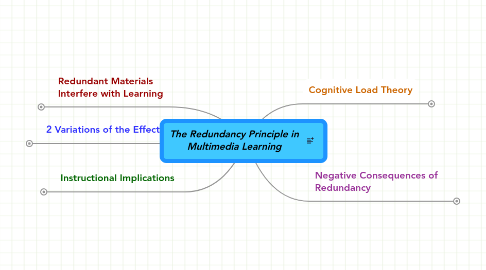The Redundancy Principle in Multimedia Learning
저자: Laura Gatto


1. Redundant Materials Interfere with Learning
1.1. Coordination of redundant info WITH essential info increases WM Load, which interferes with transfer of info to LTM.
1.1.1. New node
1.2. Occurs when same info is presented in multiple forms or is unnecessarily elaborated.
1.3. Although it may seem counterintuitive we now have theoretical explanations
2. 2 Variations of the Effect
2.1. Identical info presented to learner in 2 or more media forms. If one form is redundant then the elimination of that form can result in enhanced learning. a.k.a. Redundancy Effect
2.2. Trying to elaborate info, additional info might be added. If the additions are redundant then the exclusion may enhance learning. Mayer (2001) calls it the Coherence Effect.
3. Instructional Implications
3.1. ELIMINATE all redundant materials presented to learners, and all redundant activity that instruction may courage learners to engage in. p.165
3.2. Redundancy principle alone does not indicate precisely what material may or may not be redundant. There's no universally applicable rule.
3.3. Apply redundancy principle in relation to Cognitive Load Theory. ASK yourself: 1) Is the diagram intelligible in isolation? If yes, may be redundant. 2) Does text add essential information? If yes, it is not redundant keep it. 3) Is the text complex to understand one element you have to simultaneously consider many other elements (HIGH ELEMENT INTERACTIVITY)? If yes, do not present with a diagram unless unavoidable. 4) If diagram is High element and potentially intelligible in isolation, no additional text should be added, whether high or low interactivity. 5) Revision is not a redundant activity.
3.4. Information should be presented in a single form only. (unless learners need to recognise particular info in multiple forms)
4. Cognitive Load Theory
4.1. Working Memory is Limited in Capacity & Duration when dealing with NOVEL information.
4.2. When presenting novel material because it will be taxing the working memory, any redundancy in instruction will cause extraneous cognitive load.
4.3. If there are two sources of information WM will have to use its resources to coordinate them. Those resources will not be available for LEARNING.
4.4. ANY redundant info, whatever form, MUST BE coordinated with ESSENTIAL information.
5. Negative Consequences of Redundancy
5.1. Miller (1937) studied children learning to read. If COW was presented with a picture of a cow instead of just presenting the word COW without the picture. Performance on reading test showed the non-redundant condition was better. Learning to read puts a HEAVY strain on working memory. Pictures detract attention. Processing the picture requires resources that could've been used to learn to read the word. The picture is redundant because it interferes with learning.
5.2. Reder & Anderson, (1982) Study showed that students learned more from summaries of chapters than from reading the whole chapter.
5.2.1. Cognitive Theory explains their results. If any portion of the whole chapter text provides all the points a learner requires then any elaboration of those points requires additional processing in WM. When the main points are intelligible on their own coordinating it with an elaborationis unnecessary and has a negative effect.
